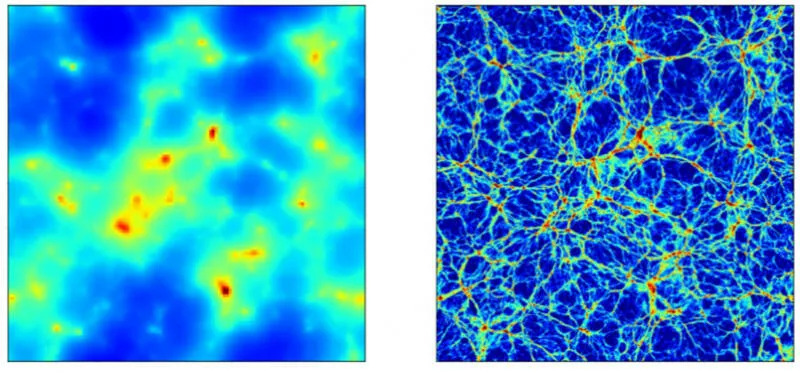Scientists have modeled the distribution of neutrinos in the universe
World science, 08 December 2020
Japanese scientists have developed a cosmological model that accurately reflects the role of neutrinos in the universe’s evolution. Simulation on its basis will allow studying the dynamics of neutrino and matter, and subsequently will lead to a robust determination of the neutrino mass. Their study has been recently published in The Astrophysical Journal.
 Density distribution of neutrinos (left) and dark matter (right) in the cosmic large-scale structure. While the neutrinos move fast and look diffuse, dark matter distribution composes cosmic webs such as filamentary structure. Image © Kavli IPMU
Density distribution of neutrinos (left) and dark matter (right) in the cosmic large-scale structure. While the neutrinos move fast and look diffuse, dark matter distribution composes cosmic webs such as filamentary structure. Image © Kavli IPMU
The effect that nearly massless, subatomic particles called neutrinos have on the formation of galaxies has long been a cosmological mystery—one that physicists have sought to measure since discovering the particles in 1956.
To make the origin and distribution of neutrinos clearer for the scientific community, Japanese scientists from the University of Tsukuba and the University of Tokyo have created a cosmological model: it accurately reflects the role of neutrinos in the evolution of the Universe. To do this, they, first, solved the Vlasov-Poisson system of equations for neutrinos with different assigned masses. It was necessary to solve the equation to understand how particles move in the Universe. So researchers accurately represent the neutrino velocity distribution function and track its change over time.
“Earlier models used certain approximations that could be wrong. In our work, we avoided these approximations by using a technique that accurately represents the neutrino velocity distribution function and tracks its evolution over time,” Koji Yoshikawa said, lead study author and fellow at the Center for Computational Science, the University of Tsukuba.
As a result, it turned out that in regions where there are many neutrinos, massive clusters of galaxies are usually present. Another important conclusion is that neutrinos suppress the clustering of dark matter and galaxies and change the temperature depending on its own mass.
“Overall, our findings are consistent with both theoretical predictions and the results of previous simulations,” says Dr Kohji Yoshikawa. “It is reassuring that the results from entirely different simulation approaches agree with each other.”
“Neutrinos are the lightest particles we know of. Our simulations are important because they set constraints on the unknown quantity of the neutrino mass,” says Shun Saito from Missouri S&T.
According to the researchers, the work is a milestone in the process of simulating the formation of the structure of the universe. The scientists hope that their work will help determine the mass of neutrinos.
Source: Kavli IPMU